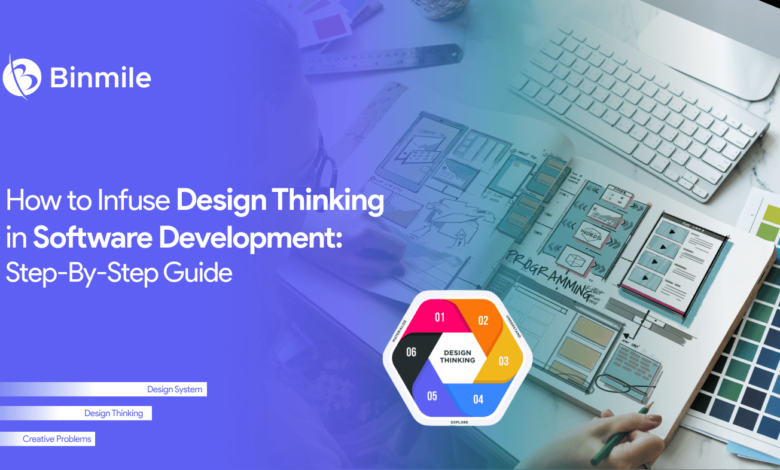
In today’s fast-paced digital landscape, creating software that truly meets users’ needs and expectations is more crucial than ever. To achieve this, many businesses are turning to design thinking—an innovative approach that prioritizes empathy, creativity, and collaboration throughout the development process. In this guide, we’ll explore how to infuse design thinking in software development to deliver exceptional results.
What is Design Thinking?
Design thinking is a human-centered approach to problem-solving that places emphasis on understanding users’ needs, generating creative ideas, and rapidly prototyping solutions. It is not just a methodology but a mindset that encourages continuous iteration and improvement. At its core, design thinking involves five key stages:
- Empathize: Understand the needs and pain points of users through observation, interviews, and immersion in their experiences.
- Define: Clearly articulate the problem based on insights gathered during the empathize stage. This involves synthesizing data and identifying user needs and motivations.
- Ideate: Generate a wide range of creative solutions without judgment. Encourage brainstorming and collaboration among team members to explore different possibilities.
- Prototype: Develop quick, low-fidelity prototypes of the most promising ideas. These prototypes are used to gather feedback from users and stakeholders.
- Test: Test prototypes with users to gather feedback and insights. Iterate on the designs based on this feedback, refining and improving them until the optimal solution is reached.
Infusing Design Thinking into Software Development
Now that we understand the principles of design thinking, let’s explore how they can be applied to software development to create user-centric solutions:
1. Understanding User Needs
In the initial stages of software development, it’s essential to empathize with users to gain a deep understanding of their needs, preferences, and pain points. This involves conducting user research, engaging in interviews, and observing user behavior. By gaining insights into users’ motivations and challenges, developers can tailor the software to address their specific requirements.
2. Defining the Problem
Once user needs have been identified, the next step is to define the problem statement. This involves synthesizing the research findings to clearly articulate the challenges that users face and the goals the software should achieve. By defining the problem statement collaboratively, teams can ensure alignment and focus throughout the development process.
3. Generating Ideas
With a clear understanding of the problem at hand, teams can begin brainstorming creative solutions. During the ideation phase, no idea is off-limits, and diverse perspectives are encouraged. Techniques such as brainstorming sessions, mind mapping, and rapid prototyping can help generate innovative ideas that address user needs effectively.
4. Prototyping Solutions
Once potential solutions have been identified, it’s time to create prototypes. Prototypes are quick, low-fidelity representations of the final product that allow teams to test ideas and gather feedback early in the development process. By rapidly iterating on prototypes, developers can refine their designs and ensure that the final product meets users’ expectations.
5. Testing with Users
User testing is a critical component of the design thinking process. By involving users early and often, developers can validate their assumptions, identify usability issues, and gather valuable feedback for improvement. Testing can take various forms, including usability testing, interviews, and surveys. By incorporating user feedback into the development cycle, teams can create software that truly resonates with its intended audience.
Benefits of Design Thinking in Software Development
The infusion of design thinking principles into software development offers numerous benefits:
- Enhanced User Experience: By prioritizing user needs and preferences, design thinking results in software that is intuitive, easy to use, and enjoyable for users.
- Increased Innovation: Design thinking encourages creativity and experimentation, leading to the development of innovative solutions that differentiate products in the market.
- Faster Time to Market: Rapid prototyping and iterative testing allow for quicker validation of ideas and accelerated development cycles, reducing time to market.
- Greater Stakeholder Satisfaction: By involving stakeholders throughout the development process, design thinking ensures that their input is valued, resulting in solutions that meet their expectations.
- Improved Problem-Solving: Design thinking fosters a collaborative and iterative approach to problem-solving, enabling teams to address complex challenges more effectively.
Choosing the Right Software Development Partner
When seeking custom software development services, it’s essential to choose a partner that embraces design thinking principles. Look for a software development company that prioritizes user-centric design, innovation, and collaboration. By selecting a partner with expertise in design thinking, you can ensure that your software projects deliver exceptional results that meet the needs of your users and stakeholders.
Conclusion
design thinking provides a robust framework for software development company to create solutions that genuinely connect with users. By integrating empathy, creativity, and collaboration into the development process, these companies can deliver innovative, intuitive, and impactful products. Whether embarking on a new software project or seeking to enhance an existing product, embracing design thinking principles can pave the way for success in today’s competitive market.
Frequently Asked Questions (FAQs) about Infusing Design Thinking in Software Development
What is design thinking, and why is it important in software development?
- Design thinking is a human-centered approach to problem-solving that emphasizes empathy, creativity, and collaboration. It’s crucial in software development because it helps create solutions that truly meet users’ needs and expectations.
How can design thinking benefit software development projects?
- Design thinking can benefit software development projects by enhancing the user experience, fostering innovation, accelerating time to market, improving stakeholder satisfaction, and facilitating effective problem-solving.
What are the key stages of the design thinking process?
- The key stages of the design thinking process include empathizing with users, defining the problem, ideating creative solutions, prototyping those solutions, and testing them with users to gather feedback for iteration and improvement.
How can software development companies integrate design thinking into their processes?
- Software development companies can integrate design thinking by incorporating user research and feedback, promoting cross-functional collaboration, fostering a culture of experimentation and iteration, and prioritizing user-centric design principles throughout the development lifecycle.
What are some examples of design thinking techniques that can be applied in software development?
- Design thinking techniques applicable in software development encompass various approaches. These include conducting user interviews, mapping user journeys, facilitating brainstorming sessions, creating rapid prototypes, conducting usability testing, and iterating based on user feedback.
How does design thinking contribute to creating user-centric software solutions?
- Design thinking contributes to creating user-centric software solutions by placing a strong emphasis on understanding users’ needs, preferences, and pain points, and by involving users in the development process through continuous feedback and iteration.
What should businesses consider when choosing a software development partner that embraces design thinking?
- When selecting a software development partner that embraces design thinking, businesses should take into account several factors. Firstly, consider the partner’s experience with user-centric design. Secondly, assess their track record of innovation. Additionally, evaluate their ability to collaborate effectively. Lastly, ensure their commitment to delivering solutions aligns with the client’s objectives and user needs.
Read Other Blogs:-



